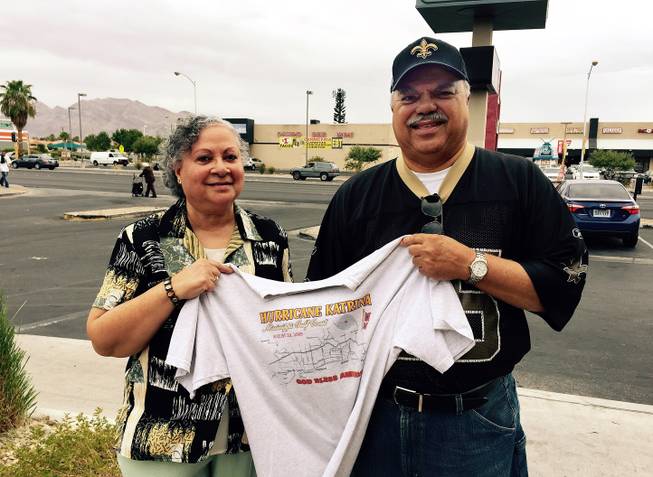
Patricia and Conrad Davillier stand in east Las Vegas, not far from their home, on Tuesday, Aug. 25, 2015. The couple moved to Las Vegas after Hurricane Katrina destroyed their Mississippi town.
Wednesday, Aug. 26, 2015 | 2 a.m.
When the television meteorologist caught his attention, Conrad Davillier was fastening his tie for Sunday Mass at his home in Diamondhead, Miss., about an hour northeast of New Orleans.
The Weather Channel’s Jim Cantore was reporting from Bay St. Louis, Miss. — a city situated along the Gulf of Mexico — as Hurricane Katrina barreled toward the shore. Davillier, now 69, and his wife, Patricia, lived in a comfortable 2,000-square-foot home a half-hour from where Cantore was reporting.
Cantore stood with the storm in the backdrop and issued a dire warning. “He said, ‘If you live north of where I’m standing and you live in a trailer, get out. It’s going to be destroyed,” Davillier recalled.
That was 10 years ago — and the moment their lives changed. Now Las Vegas residents, they reside in a quiet, age-restricted community in the eastern valley, sheltered from the perils of coastal living.
“When we talk now, it’s always before Katrina or after Katrina,” Patricia Davillier, 68, said.
Born and raised in New Orleans, the couple were prepared for big storms. In their garage, they stored large plastic tubs filled with the essentials, such as a change of clothes, toiletries, nonperishable food and medicine. Heeding Cantore’s warning, they loaded the tubs in their Honda Accord and headed east to Tallahassee, Fla., where they scrambled to find a hotel room amid the rush of evacuees.
The Davilliers stayed in Florida for a week, watching news reports of the storm making landfall Aug. 29, 2005, as a Category 3 hurricane with wind gusts up to 127 mph. Still, they weren’t expecting a “wipeout” — Conrad Davillier’s description of what they encountered when they returned home.
Pine trees chopped in half or completely toppled. Restaurants and strip malls obliterated. Sidewalks gone without a trace. Pink insulation from trailer homes scattered everywhere. Vehicles covered in mud and sludge.
“The devastation was really heartbreaking,” he said.
But the Davilliers consider themselves lucky. Their home, situated 30 feet above sea level on a hill, had withstood the storm’s fury. Only the roof was damaged, but without running water or electricity — and no hope of that returning anytime soon — the Davilliers set off for Las Vegas to temporarily live with relatives.
They returned to Diamondhead the following spring to fix up and sell their home. But overcome with chest pains while there in June 2006, Conrad Davillier wound up in a clinic — the only medical facility open because hospital infrastructure hadn’t been rebuilt yet. Medical staff suspected he was having a heart attack. Their solution: transport him via ambulance to Houston, eight hours away.
“I knew I was dead,” he said. “It was too far away.”
He made it in time for quadruple-bypass surgery and as soon as he received clearance to drive, Conrad and his wife packed a 22-foot U-Haul with their belongings and headed west once more, this time for good. Aside from family events and high school reunions, the Davilliers rarely make it back to the New Orleans area. With so many people gone, it’s not the same, they said.
Instead, they root for the New Orleans Saints from the desert and ache for authentic gumbo, French bread and roast beef po-boys. The storm, they said, seems like just yesterday. As anniversary coverage dominates media this weekend, they’ll be watching and reminiscing about how quickly a ferocious storm uprooted so many.
“It’s going to be sad,” she said. “We like it here, but we wish New Orleans would come back to the way it was.”

Join the Discussion:
Check this out for a full explanation of our conversion to the LiveFyre commenting system and instructions on how to sign up for an account.
Full comments policy